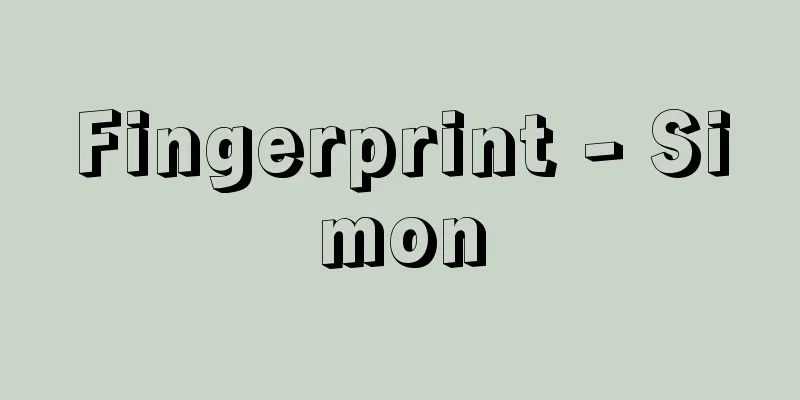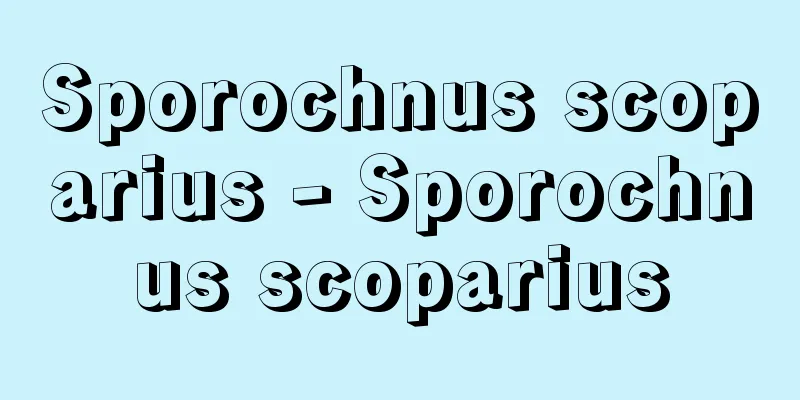Fingerprint - Simon

|
Various patterns (patterns meaning fine patterns) can be seen on the palmar side of the distal fingers, and these patterns, or the image obtained by pressing them, are called fingerprints. Looking at this area of skin histologically, the epidermis covers the top, and just below that is the dermis (tissue containing sweat glands, blood vessels, nerves, etc.). The boundary between the epidermis and dermis is wavy, and the peaks protrude into the epidermal layer (these protruding parts are called the papillary layer of the dermis), and there is a clear rise in the epidermis corresponding to this part. This is called a skin ridge, or papillary ridge (ridge). Skin ridges are formed by the countless rows of sweat pores, the outlets of sweat glands, and the valleys between these skin ridges are called skin grooves. This unique pattern of skin ridges is not limited to the palmar distal part of the fingers, but can also be seen on the palmar surface and soles of the feet, where they are called palm prints and sole prints, respectively. Fingerprints are not unique to humans; even monkeys and other animals have somewhat complex fingerprints. Fingerprints become gradually simpler in lower animals, and simple linear fingerprints can only be seen in mammals belonging to the order marsupials. At the bottom of the fingerprint are what are called tactile spheres (dactyl spheres), which are rich in nerve endings, and the sense of touch in this area is particularly sensitive. Furthermore, the wrinkles in the fingerprint increase friction when grasping an object. In other words, they act as a non-slip surface. [Furukawa Masataka] Research HistoryFingerprints began to be studied in the fields of forensic medicine and police crimes because they remain constant throughout one's life, are unique to each individual, and are extremely valuable in identifying individuals. Research on fingerprints was conducted by N. Grew and G. Bidloo of the Royal College of Physicians in England, and Italian anatomist M. Malpighi between 1684 and 1686, but it was a Czech physiologist and anatomist named J.E. Purkinje who was the first to discover individual differences in fingerprints and create a simple classification (1823). The existence of skin patterns is thought to have been known since prehistoric times, and their shapes can be found in various ruins and murals. Research has also shown that fingerprints were used to distinguish between individuals in Babylonian and Assyrian times. Furthermore, in Japan and China, there has long been a custom of making impressions of fingertips on documents and other documents, called thumbprints or nail prints. In 1880, after Purkinje had performed a simple classification, British physician H. Faulds and tax collector W. Hershel of Bengal, India, discovered that fingerprints remain constant throughout one's life. They each published their research results in the British scientific journal Nature (the former on October 28th of the same year, the latter on November 22nd). This marked the first academic proof of the value of fingerprints as personal identification. Faulds, in particular, was a physician who came to Japan in 1874 (Meiji 7) and worked at Tsukiji Hospital in Tokyo. It is said that he began researching fingerprints after observing the thumbprint and fingernail print customs that were common in Japan at the time. Later, between 1888 and 1891, British physician F. Galton confirmed that fingerprints remain constant throughout one's life and are unique to all people. According to Galton, the chance of two fingerprints matching is one in 64 billion, and the chance of all ten fingerprints matching is one in ten times. Based on Galton's work, ER Henry, also from the UK, in his position as Superintendent General of Police in India, had the police throughout India adopt fingerprinting (a method of identifying differences between individuals by the characteristics of their fingerprints) in 1897. After becoming Assistant Superintendent General of Police in London in 1901, Henry further improved the fingerprinting method and established the Henry System (also known as the Galton-Henry System), which is currently used in many countries, including the UK and the US. Around this time, many other fingerprinting methods were invented, including the Vucetich System (adopted by many South American countries) by J. Vucetich, the head of the police forensics department of the La Plata province of Argentina, and the Roscher System (also known as the Hamburg System) by T. Roscher, the Superintendent General of Police in Hamburg, Germany. In Japan, the penal code was revised in April 1908 (Meiji 41) to introduce a system of aggravated penalties for repeat offenders, but this required accurate identification of criminals, and as a result, the new and simpler Rocher system was adopted and implemented in prisons (Ministry of Justice), which became the forerunner of fingerprint technology in Japan. After that, in 1911, the police also implemented fingerprint technology based on the same Rocher system, but today the Japanese fingerprint system (ten-finger fingerprint system) has been perfected, incorporating both the Henry system and the Rocher system. [Furukawa Masataka] Fingerprint ClassificationBased on the pattern, fingerprints can be broadly classified into three types: arch, hoof, and whorl. (1) Arched pattern: A ridge that originates on one side flows to the other side and does not flow backwards. Arched patterns are further divided into "normal arched patterns" where the ridge flows relatively gently, and "protruding arched patterns" where a mountain-shaped protrusion forms in the center. (2) Hoof pattern A ridge that starts on one side and runs diagonally toward the tip of the toe, then flows back to the same side forming a hoof (like a horse's hoof). Hoof patterns are classified into "Type A Hoof Pattern" where the ridge flows back from the thumb side to the thumb side, and "Type B Hoof Pattern" where the ridge flows back from the little finger side to the little finger side. In addition, a hoof pattern should always have a delta (also called a trident) formed by a ridge on the opposite side of the flow. (3) Whorls: A general term for fingerprints with two or more deltas, in which at least one of the ridges has a curved convexity facing the side where the ridge is formed. Whorls are formed by a spiral line with a circular or elliptical center, and typical examples include "narrowly defined whorls (pure whorls)" and "annular" patterns with a similar circular center. Other types of whorls include "fetus hoof" patterns, which are very similar to hoof patterns, but have at least one reverse hoof line in the hoof line, "double hoof" patterns, which are compound patterns formed by two hoof patterns combined with their heads inverted, with both ridges forming the two hoof shapes flowing in the same direction, "twin hoof" patterns, which have ridges flowing in opposite directions, and "mixed patterns," which are formed by mixing two or more of the same or different patterns of hoofs or whorls. In rare cases, there are also abnormal fingerprints that do not belong to any of the arch, loop, or whorl patterns. These are called variant fingerprints, and examples of this include "no-touch fingerprints" that have only dots or short lines as ridges. [Furukawa Masataka] FingerprintingAs mentioned above, the ten-finger fingerprinting method once adopted by the Japanese police was the Roscher system, and this tradition has been handed down until recent years, but due to the huge amount of fingerprint data stored, the previous fingerprinting method was greatly improved in 1970 (Showa 45), and the Henry system was newly introduced as the first classification, and the classification method based on the conventional Roscher system was adopted as the second classification. The first classification is a revision of the major classification of the Henry system, which is further divided into two stages, the first classification and the second classification. In the first classification, if at least one finger among the ten fingers has a missing pattern (a large part of the distal phalange is missing and the pattern required for classification is missing), the ten-finger fingerprint is classified as "one with missing pattern" (rank 1), even if there are any fingerprints on the other fingers. Next, if even one finger among the ten has a damaged print (a fingerprint with permanent damage due to an acquired reason, and cannot be assigned a fingerprint value from 1 to 9 in the second category below), the fingerprints of those ten fingers are classified as "with damaged prints" (rank 2). In this case, if there is a missing print of rank 1 and a damaged print of rank 2 among the ten fingers, it is classified as a missing print according to the previous rank (the same rule applies to lower ranks). The third is "with an incomplete print (a temporary wound, etc., and cannot be assigned a fingerprint value from 1 to 9 in the second category below)", the fourth is "with a variant print", the fifth is "with a whorl print", the sixth is "with a type A hoof print", the seventh is "with a bow print", and the eighth is "with a type B hoof print", and so on (represented as N, S, D, C, W, R, A, and U, respectively). The secondary classification involves classifying the 10 fingerprints, which have been divided into 8 types as mentioned above, based on where on the 10 fingers the fingerprint that served as the basis for the classification is located. Detailed classification criteria and methods of expression are also established for this. The second classification is a method that has been used since 1911, and is a partial modification of the Roscher system, in which fingerprints from 10 fingers on each hand are given a fingerprint value (also called a fingerprint number) from 1 to 9. First, arched patterns are given a fingerprint value of 1, Class A loop-shaped patterns are given a fingerprint value of 2, and Class B loop-shaped patterns and whorl patterns, which are more frequent, are classified according to prescribed rules, with the former being classified into four types (fingerprint values of 3 to 6) and the latter into three types (fingerprint values of 7 to 9). Missing patterns are recorded as 0, and deformed, damaged, and incomplete patterns are recorded as ?. The fingerprints of all ten fingers are taken on a designated card, and are given a symbol or number according to each classification method. The name, date of birth, and other necessary information are then written on the fingerprints, and they are organized and stored as fingerprint sheets and fingerprint cards. In this case, the first classification has eight types, the second classification has 1023 types, and the second classification can classify 100,000 types from 00000 to 99999 for the left hand alone, and it is said that if the right hand is added, it is possible to classify more than 10 billion types. This method of classifying and organizing the fingerprints of all ten fingers is called the "ten-finger fingerprint method," and is extremely effective in identifying criminals and others. However, fingerprints of all ten fingers are not always left at crime scenes, and in practice it is necessary to identify the criminal from just one fingerprint. For this reason, Belgian criminologist E. Stockis conceived the idea of a "single-finger fingerprinting method" around 1907, and around 1910 Spanish university professor J. Olóriz also advocated the need for such a method. Then, in 1914, in addition to these two, H. Jörgensen, the superintendent general of the Copenhagen Metropolitan Police in Denmark, announced three different versions of the "single-finger fingerprinting method." Since then, many countries have invented, improved, and put into practical use these methods, but the "Battley method" by H. Battley, the head of the fingerprinting bureau of the London Metropolitan Police, in 1931, is particularly famous, and is still used as a reference in many countries today. In Japan, the "Japan National Police Agency Single-Finger Fingerprinting Method" was completed in 1956 (Showa 31), but before that, each prefecture seems to have had its own unique ideas. Subsequently, automatic computerized fingerprint identification devices were developed and put into practical use. [Furukawa Masataka] Fingerprint collectionThe most common method for taking fingerprints is to spread black fingerprint ink or printing ink thinly and evenly on a glass plate with a roller, press the tip of the finger onto it to adhere the ink, and then transfer it to paper. However, various other methods have been devised and improved. There are two methods for taking fingerprints: the finger pressure method, which simply involves pressing the finger against the plate, and the rotation method (invented by Galton), which involves rotating the finger in one direction. The former method involves using a concave finger impression, which is convenient for taking fingerprints from infants and corpses. In contrast, fingerprints at crime scenes are usually impressions made by secretions such as sweat and sebum, and are not necessarily visible to the naked eye. These are called latent fingerprints, and are revealed when aluminum powder or charcoal powder is sprinkled on the fingerprint area and then the excess powder is lightly wiped away. The fingerprint can be taken by transferring this to gelatin paper (the revealing period is about six months). Other methods include exposure to iodine vapor, or spraying with a silver nitrate solution or ninhydrin solution, but the development period is shorter, from several months to several days. In general, it is said that it is easy to collect samples from smooth surfaces such as pottery, glass, and metal, but difficult to collect samples from rough surfaces such as pieces of paper, cloth, and wood. [Furukawa Masataka] Ethnic differences and genetics of fingerprintsFingerprints are also widely used in anthropological and genetic research. The occurrence rate of each pattern varies depending on the ethnic group, and it is said that, broadly speaking, whorl patterns are more prevalent in oriental and southern sea people, while arched and hoof patterns are more prevalent in European people. This ethnic distribution can be expressed by taking the ratio of two types of patterns. First, let's define the arched pattern as A, the first type of hoof pattern as R, and the second type of hoof pattern as U (the distinction between R and U was made by Furuhata Tanemoto. Galton did not distinguish between the two and used L), and the whorl pattern as W. If we define the Furuhata index as W/R+U, the Galton index as A/L, and the Dankmeijer index as A/W, then the pattern trends of each ethnic group according to the Furuhata index are as follows: Japanese = around 80, Chinese = over 100, Italian = 60-70, American = around 50, German = 45-50, British = 35-60. According to the Furuhata index, the Ainu are said to have a score of around 50, and their fingerprints show that they are a people with characteristics similar to Westerners. Fingerprints are almost fully formed at about 18 weeks of fetal development. After that, the thickness and spacing of the ridges increase with development, but the shape of the pattern does not change, and it is said to remain constant throughout life and be unique to everyone. However, fingerprints are highly similar between close relatives, and many studies have been conducted to prove this genetic control. This point should be somewhat convincing just by comparing the fingerprints of parents and children or siblings. In other words, parents with many arch-shaped patterns will produce children with many arch-shaped patterns, parents with many hoof-shaped patterns will produce children with many hoof-shaped patterns, and parents with many whorl-shaped patterns will also produce children with many whorl-shaped patterns. Also, twins (especially identical twins) tend to have more similar patterns than other siblings. Such genetic research into fingerprints has become popular since the 1920s. For example, many reports have been published, such as one investigating the genetic relationship between parents and children in terms of the number of ridges, width and height of fingerprints (K. Bonnevie, 1924), and one investigating the genetic relationship between ridge flow direction (H. Grüneberg, 1929). In particular, Toyoji Matsukura considered arch (A), hoof (L), and whorl (W) as the basic types of fingerprints, and bow-hoof (AL), hoof-whorl (LW), and bow-whorl (AW) as intermediate types, and considered that as generations of parents and children pass, simple structures change to complex structures, or vice versa, and that these fingerprint types have a circular transition relationship (AALLLWWAWA). To facilitate this genetic analysis, he assigned values of A = 6, AL = 12, L = 18, LW = 24, W = 30, and AW = 0, and called the total value for the 10 fingers the biological fingerprint value, and used this to explain the genetic relationship between parents and children (1952). Matsukura further investigated the genetic relationship between the number of ridges and proved that this also coincided perfectly with the former law (parent-child genetic law of the number of ridges). In the past, this type of research was also applied to parent-child testing in the field of forensic medicine, but with the development of DNA testing and other techniques, its significance has declined. [Furukawa Masataka] "Fingerprints" by Okada Susumu (1958, Nagano City, Reibunsha)" ▽ "Fingerprints: Theory and Practice" by Mitsusue Yoshi (1973, Kindai Keisatsusha)" ▽ "New Legal Medicine" by Ueno Masayoshi (1977, Nanzando)" ▽ "Fingerprints" by Fujiwara Shoichi (1978, Nagano City, Reibunsha)" ▽ "Legal Medicine, edited by Matsukura Toyoji, 2nd revised edition (1979, Nagai Shoten)" [Reference] | | |©Shogakukan "> Fingerprint Classification Source: Shogakukan Encyclopedia Nipponica About Encyclopedia Nipponica Information | Legend |
|
手指末節部の手掌側には種々の紋理(理とは細かいあやの意)を認めるが、その紋理、もしくはこれを押捺(おうなつ)して得られる像を指紋という。この部分の皮膚を組織学的にみると、まず、いちばん上を表皮が覆い、すぐその下には真皮(汗腺(かんせん)、血管、神経等の分布する組織)がある。表皮と真皮の境界部は波状を呈し、その山の部分は表皮層に突出した形状をなしており(この突出部を真皮の乳頭層という)、この部に相当して表皮にも明らかな高まりがみられる。これを皮膚小稜(しょうりょう)、もしくは乳頭隆線(隆線)という。皮膚小稜は、汗孔という汗腺の出口が無数に並んで形成されたものであり、この皮膚小稜間の谷の部分は皮膚小溝とよばれる。皮膚小稜がこのように独特な紋理を描くのは手指の掌側末節部だけに限られているのではなく、その他の手掌面や足蹠(そくしょ)部(足の裏)にもみられ、それぞれ手掌紋、足蹠紋といわれている。また、指紋は人間に特有なものではなく、サルなどでも、やや複雑な指紋がある。指紋は下等動物になるほど漸次単純化し、有袋目に属する哺乳(ほにゅう)動物では簡単な線状指紋が認められる程度である。指紋の下部には神経終末装置に富む触覚小球(指小球)といわれるものがあり、この部分の触覚はとくに鋭敏である。しかも指紋のしわは、物をつかむ場合には摩擦を大きくする働きをもっている。つまり、滑り止めの役割を果たしているわけである。 [古川理孝] 研究史指紋が法医学や警察鑑識の分野で研究されるようになったのは、それが終生不変・万人不同で、その個人識別上の価値が非常に高いためである。指紋の研究は1684~86年ころ英国王室医科大学のグルーN. GrewやビドルーG. Bidloo、イタリアの解剖学者マルピーギM. Malpighiらによって行われているが、指紋に個人差のあることをみいだし、簡単な分類を行ったのはプルキンエJ. E. Purkinjeというチェコの生理・解剖学者が最初である(1823)。 ところで、このような皮膚紋理の存在はすでに有史以前から知られていたと思われ、種々の遺石や壁画類のなかに、その形がみいだされる。また、バビロニアやアッシリアの時代には、個人の異同を識別する目的で指紋を利用していたという研究も出されている。さらに、日本や中国では、古くから拇印(ぼいん)とか爪印(つめいん)と称し、証文等に指先の印象を押す習慣があった。 プルキンエが簡単な分類を行ったあとの1880年、指紋が終生不変であることをイギリスの医師フォールズH. Fauldsと、インド・ベンガル州の収税官ハーシェルW. Hershelがみいだした。両者は、それぞれイギリスの科学雑誌『ネイチャー』Natureに、その研究結果を発表(前者は、同年10月28日、後者は11月22日)している。これによって、指紋の個人識別的価値が初めて学問的に証明されたといえるわけである。とくにフォールズは、1874年(明治7)に来日し、東京築地(つきじ)病院に勤務していた医師で、当時の日本で行われていた拇印や爪印の習慣をみて指紋の研究に着手したともいわれている。その後、1888~91年ころにイギリスのゴルトンF. Galtonによって指紋の終生不変・万人不同の事実が確認された。ゴルトンによると、2個の指紋が一致する可能性は640億回に1回であり、10指すべての指紋が一致する可能性は、さらにその10乗回に1回とのことである。ついでその業績を基礎として、同じくイギリスのヘンリーE. R. Henryが、インドの警視総監としての立場から、1897年、インド全域の警察に指紋法(指紋の特性によって個人の異同を識別する方法)を採用させている。ヘンリーは、1901年にロンドンの警視総監補となったのちにも、さらに指紋法に改良を加え、現在、イギリス、アメリカをはじめ、多くの国々が採用しているヘンリー・システム(ゴルトン‐ヘンリー・システムともいう)を確立した。なお、この前後にはアルゼンチン・ラプラタ州の警察鑑識局長であるベセッチJ. Vucetichによるベセッチ・システム(南アメリカの各国が採用)、ドイツのハンブルク警視総監であるロッシャーT. Roscherによるロッシャー・システム(ハンブルク・システムともいう)など、多数の指紋法が考案されている。 日本では1908年(明治41)4月に刑法を改正し、累犯加重の制度を定めたが、これには犯罪人の正確な異同識別が必要であり、その結果、当時としては新しく、しかもより簡便なロッシャー・システムが採用され、監獄(司法省)において実施されたのが、日本における指紋法の先駆けである。その後1911年から警察においても同様のロッシャー・システムによる指紋法が実施されるようになったが、現在はヘンリー・システムとロッシャー・システムの両方を取り入れた日本式指紋法(十指指紋法)が完成されている。 [古川理孝] 指紋の分類指紋はその紋様から、弓状紋、蹄状(ていじょう)紋、渦状(かじょう)紋のほぼ3種類に大別できる。 (1)弓状紋 一側より生じた隆線が反対側へ流れ、その隆線の流れが逆流することのないものをいう。弓状紋は、さらに、隆線の流れが比較的なだらかな「普通弓状紋」と、中央部で山形に突起を形成する「突起弓状紋」とに区別される。 (2)蹄状紋 一側から生じた隆線が指の先端部に向かって斜めに進み、ついで蹄形(ウマのひづめの形)をなして同一側へ還流するものをいう。蹄状紋は隆線が母指側から母指側へ還流する「甲種蹄状紋」と、小指側から小指側へ還流する「乙種蹄状紋」に区別される。なお、蹄状紋には、隆線で形成される三角州(デルタ、三叉(さんさ)ともいう)がその流れの反対側にかならず1個認められるはずである。 (3)渦状紋 隆線のうち少なくともその1本が隆線の生じた側に彎曲(わんきょく)した凸部を向けているもので、三角州を2個以上有する指紋の総称である。渦状紋は、中心部が円ないし楕円(だえん)形の渦状線で形成されるもので、「狭義渦状紋(純渦状紋)」や、中心部が同様の環状線で形成されている「環状紋」等が典型例である。このほか、渦状紋には、蹄状紋に酷似しているが、蹄線のなかに少なくとも1本の逆向きの蹄線を有する「有胎(ゆうたい)蹄状紋」、2個の蹄状紋が頭部を逆位にして組み合わさった形の合成紋で、2個の蹄状を形成する隆線が両方とも同一方向に流れる「二重蹄状紋」、隆線がおのおの反対方向に流れる「双胎蹄状紋」のほか、蹄状紋か渦状紋の同種紋様あるいは異種紋様が2個以上混在して形成される「混合紋」等が含まれる。 また、ごくまれには、弓状紋、蹄状紋、渦状紋のいずれにも属さない異常な形状の指紋もある。これを変体紋といい、たとえば隆線が点や短線だけの「無体紋(無指紋)」はこれに含まれる。 [古川理孝] 指紋法前述のごとく、かつて日本の警察で採用した十指指紋法はロッシャー・システムであり、その伝統は近年まで受け継がれてきたが、保管されている指紋資料が膨大になったことなどから、1970年(昭和45)にそれまでの指紋法が大改善され、新たに第1分類としてヘンリー・システムが取り入れられ、第2分類として従来どおりのロッシャー・システムによる分類方式がとられるようになった。第1分類とはヘンリー・システムの大分類を修正したもので、さらに第1次分類と第2次分類の二段階に分けられている。第1次分類とはまず10指のなかに1指でも欠如紋(手指末節部の大部分が欠如しており、分類に必要な紋様が欠けているもの)がある、他の指にいかなる指紋があってもその10指指紋は「欠如紋があるもの」という種別(順位1)に分類される。次に10指のなかに1指でも損傷紋(指紋のなかに後天的な理由で永久的な損傷があり、後記第2分類の1~9までの指紋価がつけられないもの)があると、その10指指紋は「損傷紋があるもの」という種別(順位2)に分類される。この場合、10指中に第1順位の欠如紋と第2順位の損傷紋を有するときには、先順位に従って欠如紋として分類される(以下順位が下がっても同様の規則に従う)。第三は「不完全紋(一時的な創傷等があり、後記第2分類の1~9までの指紋価がつけられないもの)があるもの」、第四は「変体紋があるもの」、第五は「渦状紋があるもの」、第六は「甲種蹄状紋があるもの」、第七は「弓状紋があるもの」、第八は「乙種蹄状紋があるもの」というように8種類(順次N・S・D・C・W・R・A・Uと表現)に分類される。第2次分類とは、前述のごとく8種類に分類された10指指紋について、その分類の基準となった指紋が10指のどこにあるかによって分類するもので、これにも詳細な分類規準や表現方法が定められている。 次に第2分類とは1911年以来行ってきた方法で、ロッシャー・システムを一部修正したものであるが、左右10指分の指紋にそれぞれ1~9までの指紋価(指紋番号ともいう)が与えられる。まず弓状紋の指紋価を1、甲種蹄状紋を2、頻度の高い乙種蹄状紋と渦状紋は規定の方則に従って、前者は4種(指紋価は3~6)、後者は3種(指紋価は7~9)に区分される。なお欠如紋は0、変体紋は、損傷紋は、不完全紋は?と記録する。 10指分の指紋は所定のカードに採取し、それぞれの分類法による記号や数値がつけられ、さらに氏名、生年月日、その他必要事項が記入されて、指紋原紙および指紋票として整理・保管される。この場合、第1分類では第1次分類で8種類、第2次分類で1023種類、第2分類では左手だけでも00000~99999の10万種が分類でき、これに右手の分を加えると100億種以上もの分類が可能といわれている。このように10指すべての指紋を分類・整理する方法を「十指指紋法」といい、犯罪者等の異同識別には絶大な威力を発揮する。しかし犯罪現場等には10指分すべての指紋が残されているわけではなく、実務上はたった1個の指紋からでも犯人を割り出すことが必要とされる。このため、ベルギーの犯罪学者ストッキーE. Stockisは1907年ころに「一指指紋法」を企図し、10年ころからはスペインの大学教授オロリーツJ. Olórizもその必要性を唱えたといわれている。そして、1914年になると、両者のほかにデンマークのコペンハーゲン警視総監ヨルゲンセンH. Jörgensenが、それぞれ三様の「一指指紋法」を発表した。その後は続々と各国で創案、改良され、実用化されていくが、なかでも、1931年のロンドン警視庁指紋局長バトレーH. Battleyによる「バトレー法」は有名で、現在でも、これを参考にしている国々は多い。日本では、1956年(昭和31)に「日本警察庁一指指紋法」が完成されたが、それ以前は、各都道府県において独自のくふうがなされていたようである。 なお、その後コンピュータによる指紋自動識別装置も開発され、実用化されている。 [古川理孝] 指紋の採取指紋を採取するには、ガラス板上に指紋用黒インキ、もしくは印刷用インキ等をローラーで薄く均一に延ばし、その上に指頭を押し付けてインキを付着させ、紙面に転写する方法が一般的である。しかし、このほかにも種々の方法が考案、改良されている。また、採取方法には、単に指を押し当てるだけの指圧法と、指を左右一方向に回転させてとる回転法(ゴールトンの創案)とがある。前者には凹面の指型を用いる方法もあるが、これは乳幼児や死体の指紋採取には便利である。これに対して犯罪現場等における指紋は、通常、汗や皮脂等の分泌物が印象されたものであるため、肉眼的に識別できるとは限らない。これを潜在指紋といい、アルミニウム粉末や炭末等を散布して指紋部に付着させ、その後、余分な粉末を軽く掃いて除去すると指紋が顕出する。これをゼラチン紙に転写すれば指紋が採取できる(顕出期間は約半年)。このほかにヨード蒸気を当てる方法、硝酸銀溶液やニンヒドリン溶液を噴霧する方法等もあるが、顕出期間は数か月から数日と短くなる。一般に陶器、ガラス、金属等の平滑なものからは採取しやすく、表面の粗な紙片、布片、木材等からは採取しにくいといわれる。 [古川理孝] 指紋の民族差と遺伝人類学的、遺伝学的研究にも指紋はかなり応用されている。民族によって各紋様の出現率に差があり、大きく分けて、東洋系や南洋系には渦状紋が多く、ヨーロッパ系には弓状紋や蹄状紋が多いといわれている。この民族特有の分布は、2種類の紋様の比をとることによって表すことができる。まず弓状紋をA、甲種蹄状紋をR、乙種蹄状紋をUとし(RとUの区別は古畑種基(ふるはたたねもと)による。ゴールトンは両者を区別せずL)、渦状紋をWとした場合、古畑指数はW/R+U、ゴールトン指数はA/L、ダンクマイヤーDankmeijer指数はA/Wで表される。古畑指数によって各民族の紋様の傾向をみると、日本人=ほぼ80前後、中国人=100以上、イタリア人=60~70、アメリカ人=50前後、ドイツ人=45~50、イギリス人=35~60となる。なお、古畑指数によるとアイヌは50前後といわれ、指紋からみると欧米人に近い特徴を有する民族であることが認められる。 指紋は胎生18週くらいでその原形がほぼ完成し、以後、発育に伴って隆線の太さ、間隔は大きくなっていくが、紋様の形状は変化せず、終生不変・万人不同といわれている。しかし、指紋は近親間での類似性が高く、その遺伝支配を証明する研究も数多く行われている。この点については親子・兄弟間の指紋を比較してみるだけでも、ある程度は納得がいくはずである。すなわち、弓状紋の多い両親からは弓状紋の多い子が、蹄状紋の多い両親からは蹄状紋の多い子が、そして渦状紋の多い両親からはやはり渦状紋の多い子ができ、また、双生児(とくに一卵性)の場合は、他の兄弟よりも紋様の類似性が高いということなどを念頭に置いてみるとよい。このような指紋の遺伝学的研究は1920年代以降になって盛んになったものである。たとえば、隆線数、指紋の幅や高さについて親子の遺伝関係を調査したもの(ボンヌビーK. Bonnevie、1924)、隆線の流れ方向について遺伝性を調べたもの(グリューネベルクH. Grüneberg、1929)など、多数の報告が出されている。とくに松倉豊治は指紋の基本型として弓状紋(A)・蹄状紋(L)・渦状紋(W)、中間型として弓蹄紋(AL)・蹄渦紋(LW)・弓渦紋(AW)を考え、親子の世代を経るにしたがって簡単な構造から複雑な構造へ、またはその逆方向へと変異し、これらの指紋型には環状の移行関係(AALLLWWAWA)が成り立つものとみなした。そしてこの遺伝学的解析を容易にすべく、A=6、AL=12、L=18、LW=24、W=30、AW=0なる数値を与え、その10指分の合計値を生物学的指紋価と称し、これに基づいて親子間の遺伝関係を説明した(1952)。松倉はさらに、隆線数についても同様の遺伝関係を調べ、これも前者の法則と完全に一致することを証明した(隆線数の親子間遺伝法則)。かつては法医学の分野において、このような研究も親子鑑定などに応用されたが、DNA鑑定などが発達した現在では、その意義は低下している。 [古川理孝] 『岡田鎭著『指紋』(1958・長野市・令文社)』▽『光末義著『指紋・その理論と実際』(1973・近代警察社)』▽『上野正吉著『新法医学』(1977・南山堂)』▽『藤原正一著『指紋』(1978・長野市・令文社)』▽『松倉豊治編著『法医学』増補第2版(1979・永井書店)』 [参照項目] | | |©Shogakukan"> 指紋の分類 出典 小学館 日本大百科全書(ニッポニカ)日本大百科全書(ニッポニカ)について 情報 | 凡例 |
<<: Advisory body - Simon Kikan
Recommend
Phyllotaxis
...the leaf blade is formed in the upper leaf, an...
sacrum consistorium
...the empire was completely transformed from a p...
Hilbert space
Around 1900, German mathematician Hilbert propose...
kyphosis
...Generally, it refers to domestic cats, i.e. ho...
Edelfelt, A. (English spelling) EdelfeltA
…The first Finnish landscape painter to be inspir...
Financial statement - kessanhokokusho
It is a general term for documents prepared as the...
Managed Prostitution
…The brothels were large, but the sake shops were...
Dehumidifier - with a steamer
A device that draws in indoor air, brings it into ...
Endo Tanenori
1793-1870 A daimyo in the late Edo period. Born o...
"Suga Family Manyoshu" - Kanke Manyoshu
…According to the preface, it was compiled in 893...
Whaling ship - Hogeisen (English spelling) Whale catcher
Also called a catcher boat. A fast boat used for c...
Kumano Lumber Wholesaler - Itazai Mokkumanodoiya
…Kumano Wholesalers used to transport lumber from...
Ben Hur
A novel written by American lawyer, politician, an...
Rocket - Rocket
A bullet propelled by a rocket engine. Source: The...
paśu (English spelling) pasu
…These scriptures are said to have been preached ...









